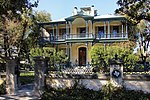San Antonio Downtown and River Walk Historic District
The San Antonio Downtown and River Walk Historic District is an amalgamation of residential and commercial sites. 197 contributing properties and 50 non-contributing properties were taken into consideration when evaluating the area for the National Register of Historic Places (NRHP) and also for the Recorded Texas Historic Landmarks (RTHL). The more than a century of economic growth and business/tourist development beginning in the mid-19th century is reflected in the city's architecture.The commercial buildings showcase a wide variety of architectural styles and movements. Among the prominent architects who were involved in designing this area of San Antonio were Atlee Ayres, Alfred Giles, James Riely Gordon, Robert H.H. Hugman, Herbert M. Greene, Adams & Adams (Carleton W. Adams and his uncle Carl C. Adams) and Millard Sheets.Listed below are 37 properties denoted as significant to the designation of the National Register of Historic Places listings in Bexar County, Texas. Four of the properties are also included on La Villita historic district. The 214-acre geographical boundaries covered by this NRHP designation are the San Antonio River Walk and surrounding blocks, bounded by Cameron, Augusta, Sixth, Bonham, losoya and Tolle Place.
Excerpt from the Wikipedia article San Antonio Downtown and River Walk Historic District (License: CC BY-SA 3.0, Authors).San Antonio Downtown and River Walk Historic District
Wickes Street, San Antonio
Geographical coordinates (GPS) Address Nearby Places Show on map
Geographical coordinates (GPS)
| Latitude | Longitude |
|---|---|
| N 29.411111111111 ° | E -98.492777777778 ° |
Address
Wickes Street 138
78210 San Antonio
Texas, United States
Open on Google Maps





